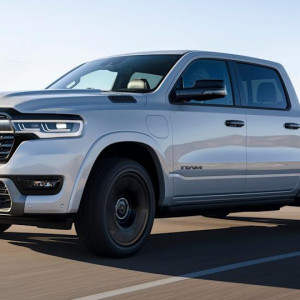How extended-range EV hybrids work

The extended-range electric vehicle is headed to showrooms starting next year. With an extended-range EV, a vehicle can drive exclusively on electric power even after the energy in the battery pack is consumed. Extended-range EVs use a gasoline engine mated to a generator to feed electricity to the vehicle's drive motors.
Here's a primer on how range extenders work.
Do extended-range EVs have to be plugged in?
No, but extended-range EVs are designed to deliver maximum[1] efficiency and fuel economy when the battery pack is fully charged. On an extended-range EV such as the Ram 1500 Ramcharger, the battery pack alone powers the vehicle for the first 145 miles. The Ramcharger's 27-gallon fuel tank enables a total range of 690 miles.
When the gasoline engine starts, it powers a generator that creates electricity for the electric motors that drive the wheels. But extended-range EVs can operate normally without plugging in or, if the battery pack is charged, without the gasoline engine running.

Extended-range EVs make a comeback as hybrid sales rise[2]

How is an extended-range EV different from a regular plug-in hybrid, such as a Ford Escape Hybrid or a Toyota Prius?
On non-range extended hybrids, including plug-ins[4], the gasoline engine has a mechanical connection to the wheels and drives the vehicle in conjunction with the electric motor or by itself. The gasoline engine in an extended-range EV powers only the generator.
There is no path for torque from the engine to flow to the wheels. Some future range extenders may operate slightly differently. German supplier ZF's next-generation range extender, eRE+, slated for a Chinese market SUV next year, will have a clutch and differential in the transmission that can send torque to the wheels.
Are extended-range EVs more efficient than other hybrids?
They can be.
There's less energy lost to internal mechanical friction because an extended-range EV doesn't have a transmission. But efficiency also depends on how and where the vehicle is driven and other factors, such as temperature. Extended-range EVs could offer efficiency gains over other types of hybrids because they have larger battery packs and can travel farther on electricity from the grid.
Most plug-in hybrids have less than 30 miles of electric range, more than four times smaller than the Ramcharger's 145 miles of electric range. Advertisement Advertisement
Since the gasoline engine does not drive the vehicle, it also won't feel exactly like a hybrid.
That's because the engine revs are not directly related to vehicle speed.
Sign up for the weekly Automotive News Mobility Report newsletter for the latest developments at the intersection of transportation and technology.[5]
Have extended-range EVs been sold before?
Yes. The Chevrolet Volt and some versions of the BMW i3, both now out of production, had extended-range EV powertrains. So did the failed Fisker Karma.
Why are automakers trying again with extended-range EVs?
Consumers generally like the instant torque and smooth, quiet power of the electric drivetrain.
But EV sales are rising more slowly than they did a few years ago, and automakers are adding more hybrids to their product plans. Hybrid sales, including conventional and plug-ins[6], increased 2.4 percent in 2024, compared with a 0.8 percent rise in EV sales, according to J.D. Power.
What are the downsides of an extended-range EV?
As with other gasoline-powered vehicles, extended-range EVs need oil changes and tune-ups. An extended-range EV weighs more than a conventional hybrid or combustion vehicle, mostly because of a large battery pack that gives it longer range than standard plug-in hybrids.
Send us a letter to the editor[7]
Have an opinion about this story?
Tell us about it and we may publish it in print. Click here to submit a letter to the editor.[8]
References
- ^ are designed to deliver maximum (www.autonews.com)
- ^ Extended-range EVs make a comeback as hybrid sales rise (www.autonews.com)
- ^ What is a hybrid vehicle? (www.autonews.com)
- ^ including plug-ins (www.autonews.com)
- ^ Sign up for the weekly Automotive News Mobility Report newsletter for the latest developments at the intersection of transportation and technology. (www.autonews.com)
- ^ Hybrid sales, including conventional and plug-ins (www.autonews.com)
- ^ Send us a letter to the editor (www.autonews.com)
- ^ Click here to submit a letter to the editor. (www.autonews.com)